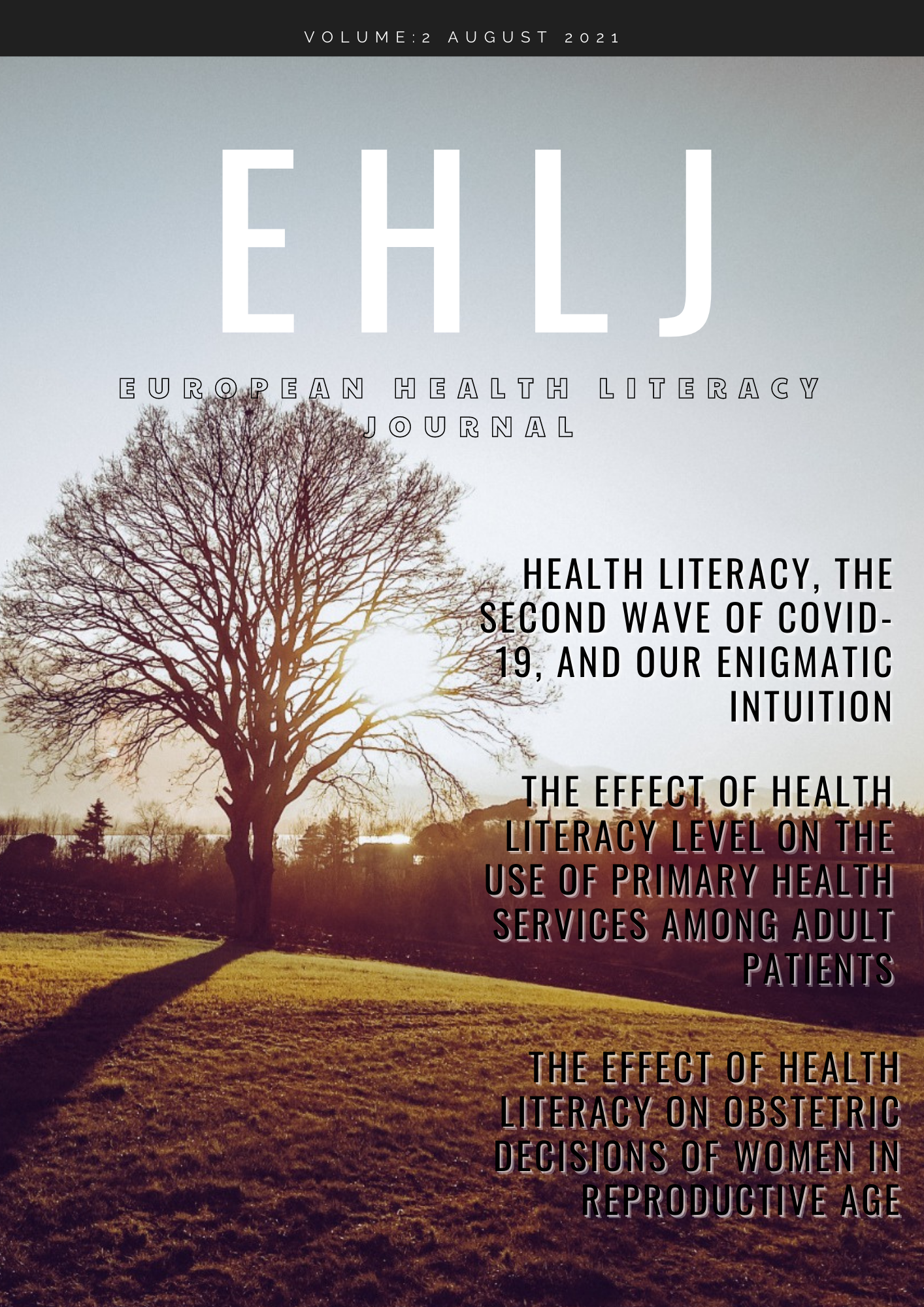Author :
Abstract
Keywords
Abstract
Aim: In this study, we aimed to determine and evaluate the relationship between health attitudes, use
of health services and health literacy levels of adult patients registered in the "Hürriyet Educational
Family Health Center" where we provide primary health care services in our family medicine clinic.
Methods: In our study, 242 patients admitted to the Hürriyet Education Family Health Center, aged
between 18-80 years, underwent a two-stage questionnaire face-to-face. In the first part, the patients
were asked questions on sociodemographic data as well as the use of primary health care services and
their attitudes. In the second part, HL levels were determined using the TSOY-32 (Turkish Health Literacy
Questionnaire-32) scale, which measures the HL levels of participants.
Results: The total sample size was 242. Of the participants, 51.2% (n=124) were female and 48.8%
(n=118) were male. The HL scores of the participants on the TSOY-32 were determined. The average
score was calculated as 29.77±5.36. Inadaquate, problematic, sufficient and excellent health literacy
levels were distributed as 13%, 64%, 22% and 1%, respectively. Health literacy scores of participants
who applied to health institutions in acute or urgent situations were higher than those who applied only
for prescription medicine. It was found that the mean scores of the group without any disease were
higher than the group with one disease or the group with more than one disease. Evaluating primary
health care service usage, it was determined that patients who were over 50 years old and gave a stool
sample had a greater representation in the high HL group than those who did not. Likewise, women over
40 years who had mammography screening had a greater representation in the high HL group than
those who did not. Looking at the aspect of cervical cancer screening tests, more women had a
papsmear test in the high HL group than those who did not.
Conclusions: Health literacy has an increasingly important place due to the increasing elderly population
and the increasing number of patients with chronic diseases. Health literacy affects patient health
attitudes on healthcare, outpatient appointments, family physician visits, usage of primary care services
and cancer screening programs. All these subjects are important factors for improving the health of
society. Family physicians should take great steps to improve the health literacy of their registered
patients, since primary prevention starts with patient knowledge about health literacy.
Keywords
- 1. Simonds SK. Health Education as Social Policy. Health Educ Monogr. 1974; 2(1): 1–10.
- COMPARATIVE REPORT ON HEALTH L ITERACY IN EIGHT The European Health Literacy Survey (HLS-EU). 2012.
- Critical Health Competence Test (CHC Test). Adv Heal Sci Educ. 2009; 14(1): 11-22.
- Health literacy and the risk of hospital admission. J Gen Intern Med. 1998; 13(12): 791-798.
- Organisation. 2005.
- 6. Corona G, Casetta B, Sandron S, Vaccher E, ToffoliG. Rapid and sensitive analysis of vincristine in humanplasma using on-line extraction combined with liquidchromatography/tandem mass spectrometry. RapidCommun Mass Spectrom. 2008; 22(4): 519-525.
- 7. Kickbusch I, Wait S, Maag D. Health Literacy: a Call to Action. 2006.
- 8. Yilmazel G, Cetinkaya F. The importance of healthliteracy for community health. TAF Prev Med Bull. 2016; 15(1): 69.
- to measure it? Why is it important? Turkish J Fam Med Prim Care. 2016; 10(1): 40.
- Sendikası. Sağlık-Sen Yayınları-25, Ankara. 2014;
- 11. Sørensen K, Van den Broucke S, Pelikan J, et al.Measuring health literacy in populations: illuminatingthe design and development process of HLS-EU-Q. BMC Public Health. 2013;13(1):1–10.
- 12. Okyay P, Abacıgil F. Türkiye Sağlık OkuryazarlığıÖlçekleri Güvenı̇lı̇rlı̇k ve Geçerlı̇lı̇k Çalışması. Sağlık Bakanlığı; 2016; 24–41.
- Okuryazarlığı Durumunun Değerlendirilmesi Evaluationof the Health Literacy Status Among Individuals Aged18-65 Registered in a Family Health Center. Sak Tıp Derg. 2018; 8(3): 575-581.
- to A University Hospital Polyclinic. Eurasian J Fam Med [Internet]. 2019; 8(1): 27–35.
- AVRASYA Uluslararası Arastırmalar Derg. 2018; 6(15): 467-488.
- literacy among adults: a study from Turkey. Health Educ Res [Internet]. 2010; 25(3): 464-477.
- OKURYAZARLIĞI DÜZEYİNİN BELİRLENMESI. Manisa CBU J Inst Heal Sci. 2017;4.
- Slonska Z, Doyle G, et al. Health literacy in Europe:comparative results of the European health literacysurvey (HLS-EU). Eur J Public Health. 2015; 25(6): 1053-1058.
- Taiwan. Asia Pacific J Public Heal. 2015; 27(8): 871– 20. Nakayama K, Osaka W, Togari T, et al.
- Comprehensive health literacy in Japan is lower than inEurope: a validated Japanese-language assessment ofhealth literacy. BMC Public Health. 2015; 15(1): 505.
- communication strategies into the 21st century. Health Promot Int. 2000; 15(3): 259-267.
- Australian population may have suboptimal healthliteracy depending upon the measurement tool:Results from a population-based survey. Health Promot Int. 2009; 24(3): 252-261.
- Epidemiol Community Heal. 2007; 61(12): 1086–1090.24. Baker DW, Gazmararian JA, Williams M V, et al.
- Health literacy and use of outpatient physician servicesby medicare managed care enrollees. J Gen Intern Med. 2004; 19(3): 215–20.
- 25. Davis TC, Dolan NC, Ferreira MR, et al. The Role ofInadequate Health Literacy Skills in Colorectal CancerScreening. Cancer Invest. 2001; 19(2): 193–200.
- Outcomes: An Updated Systematic Review. Ann Intern Med. 2011; 155(2): 97.
- 27. Davis TC, Arnold C, Berkel HJ, Nandy I, JacksonRH, Glass J. Knowledge and attitude on screeningmammography among low-literate, low-incomewomen. Cancer. 1996; 78(9): 1912-1920.
- 28. Marcus AC, Crane LA. A Review of Cervical CancerScreening Intervention Research: Implications forPublic Health Programs and Future Research. Prev Med (Baltim). 1998; 27(1): 13-31.
- limited health literacy. J Gen Intern Med. 2005; 20(2): 175–84.
- 30. Sadeghi S, Brooks D, Stagg-Peterson S, GoldsteinR. Growing Awareness of the Importance of HealthLiteracy in Individuals with COPD. COPD J Chronic Obstr Pulm Dis. 2013; 10(1): 72–8.





